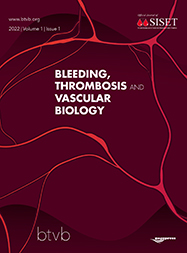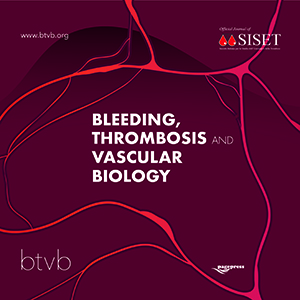Reviews
Vol. 3 No. 2 (2024)
The evolving landscape of gene therapy for congenital severe hemophilia: a 2024 state of the art

Publisher's note
All claims expressed in this article are solely those of the authors and do not necessarily represent those of their affiliated organizations, or those of the publisher, the editors and the reviewers. Any product that may be evaluated in this article or claim that may be made by its manufacturer is not guaranteed or endorsed by the publisher.
All claims expressed in this article are solely those of the authors and do not necessarily represent those of their affiliated organizations, or those of the publisher, the editors and the reviewers. Any product that may be evaluated in this article or claim that may be made by its manufacturer is not guaranteed or endorsed by the publisher.
Received: 21 June 2024
Accepted: 27 June 2024
Accepted: 27 June 2024
1173
Views
362
Downloads
Similar Articles
- Eleonora Petito, Anna Maria Mezzasoma, Emanuela Falcinelli, Chiara Conti, Erica De Candia, Raimondo De Cristofaro, Silvia Sorrentino, Gian Marco Podda, Mariangela Scavone, Anna Falanga, Marina Marchetti, Luca Barcella, Stefania Basili, Lucia Stefanini, Andrea Boccatonda, Laura Contino, Patrizia Sciancalepore, Igor Florio, Egidio Imbalzano, Rossella Marcucci, Angela Rogolino, Patrizia Noris, Marta Panella, Rita Santoro, Maria Costanza Turi, Gaetano Vaudo, Rosa Curcio, Paolo Gresele, Persistence of functional anti-PF4 antibodies and neutrophil activation in vaccine-induced immune thrombotic thrombocytopenia , Bleeding, Thrombosis and Vascular Biology: Vol. 4 No. 3 (2025)
- Renato Marino, Silvia Linari, Marzia Leotta, Antonio Coppola, Chiara Biasoli, Maria Elisa Mancuso, Flora Peyvandi, Cristina Santoro, Ezio Zanon, Rita Carlotta Santoro, Diagnostic and management practices for inherited fibrinogen disorders: a nationwide survey of Italian Hemophilia Treatment Centers , Bleeding, Thrombosis and Vascular Biology: Vol. 4 No. 3 (2025)
- Roger Lijnen, Désiré Collen, The key to fibrinolysis and thrombolysis , Bleeding, Thrombosis and Vascular Biology: Vol. 4 No. 3 (2025)
- Alice Lipari, Esmeralda Capristo, Antonietta Ferretti, Erica De Candia, Anticoagulation in obese patients: challenges and strategies , Bleeding, Thrombosis and Vascular Biology: Vol. 4 No. 3 (2025)
- Silvia Linari, Renato Marino, Marzia Leotta, Antonio Coppola, Patrizia Di Gregorio, Augusto Bramante Federici, Flora Peyvandi, Cristina Santoro, Ezio Zanon, Rita Carlotta Santoro, The landscape of rare coagulation factor deficiency management in Italy: a national hemophilia center survey , Bleeding, Thrombosis and Vascular Biology: Vol. 4 No. 3 (2025)
- Stefania Cavazza, Gualtiero Palareti*, Still unmet problems with low molecular weight heparin prophylaxis of venous thromboembolism. An Italian survey , Bleeding, Thrombosis and Vascular Biology: Vol. 4 No. 3 (2025)
- PO44 | Emicizumab in acquired haemophilia A , Bleeding, Thrombosis and Vascular Biology: Vol. 4 No. s1 (2025)
- Ilaria Nichele, Giuseppe Carli, Alberto Tosetto, Tailored therapy with turoctocog alfa pegol according to patient’s lifestyle and hemorrhagic phenotype: from clinical trial to real-life , Bleeding, Thrombosis and Vascular Biology: Vol. 3 No. 1 (2024)
- PO93 | Use of DOACS in heart transplantation recipients , Bleeding, Thrombosis and Vascular Biology: Vol. 4 No. s1 (2025)
- PO45 | Routine prophylaxis with PD-FX concentrate in severe inherited FX deficiency: a case report , Bleeding, Thrombosis and Vascular Biology: Vol. 4 No. s1 (2025)
1-10 of 223
Next
You may also start an advanced similarity search for this article.
Most read articles by the same author(s)
- Samantha Pasca, Cristina Santoro, Chiara Ambaglio, Marisanta Napolitano, Marta Milan, Letizia Natali, Silvia Nannizzi, Filippo Mori, Paolo Simioni, Ezio Zanon, Comparison among three different bleeding scores and the thrombin generation assay to assess the different hemorrhagic phenotypes in patients with FVII deficiency , Bleeding, Thrombosis and Vascular Biology: Vol. 1 No. 2 (2022)
- Stefano Lancellotti, Monica Sacco, Maira Tardugno, Antonietta Ferretti, Raimondo De Cristofaro, The von Willebrand factor-ADAMTS-13 axis: a two-faced Janus in bleeding and thrombosis , Bleeding, Thrombosis and Vascular Biology: Vol. 1 No. 1 (2022)
- Paolo Simioni, Vittorio Pengo, Paolo Prandoni, Thrombosis and hemostasis at the University of Padua: a reappraisal on the occasion of its 800th year of history , Bleeding, Thrombosis and Vascular Biology: Vol. 1 No. 3 (2022)
- Marco Marietta, Giancarlo Castaman, Comments on “Safe and effective anticoagulation use: case studies in anticoagulation stewardship” , Bleeding, Thrombosis and Vascular Biology: Vol. 4 No. 2 (2025)
- Cristina Santoro, Alessandro Casini, Addressing some challenges of congenital fibrinogen disorders in 2023 and beyond , Bleeding, Thrombosis and Vascular Biology: Vol. 2 No. 3 (2023)
- Anna Poretto, Elisabetta Borella, Giacomo Turatti, Michelangelo Marobin, Elena Campello, Daniela Tormene, Paolo Simioni, Luca Spiezia, Association between non-O blood type and early unexplained recurrent spontaneous abortion in women with and without inherited thrombophilia , Bleeding, Thrombosis and Vascular Biology: Vol. 1 No. 3 (2022)
- Daniela Tormene, Elena Campello, Chiara Simion, Anna Poretto, Paolo Prandoni, Paolo Simioni, Combined oral contraceptives and the risk of venous thromboembolism carriers of antithrombin, protein C or S deficiency: Sub-analysis of a prospective cohort study , Bleeding, Thrombosis and Vascular Biology: Vol. 1 No. 3 (2022)
- Giancarlo Castaman, Gene transfer in hemophilia B: a big step forward , Bleeding, Thrombosis and Vascular Biology: Vol. 2 No. 2 (2023)
- Lisa Pieri, Silvia Linari, Francesca Salvianti, Monica Attanasio, Giancarlo Castaman, Impaired platelet function in Hermansky-Pudlak syndrome associated with novel mutations in HPS3, HPS6 and HPS8 genes , Bleeding, Thrombosis and Vascular Biology: Vol. 3 No. 3 (2024)
- Silvia Linari, Renato Marino, Marzia Leotta, Antonio Coppola, Patrizia Di Gregorio, Augusto Bramante Federici, Flora Peyvandi, Cristina Santoro, Ezio Zanon, Rita Carlotta Santoro, The landscape of rare coagulation factor deficiency management in Italy: a national hemophilia center survey , Bleeding, Thrombosis and Vascular Biology: Vol. 4 No. 3 (2025)










